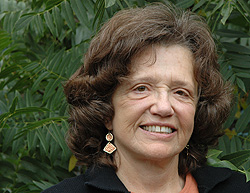Berkeleyan
Going solo, but not alone
The sociology of the new single woman
![]()
| 14 September 2005
 "The new single woman is not leading a conventionally coupled or cohabiting life," says Kay Trimberger. "She's not lonely, isolated, or a loner. She sees alternative ways to live and feels a lot of satisfaction in not investing everything in one person." (Wendy Edelstein photo) |
"I felt like there weren't any cultural guidelines for long-term single life," explains Trimberger, a visiting scholar at the Institute for the Study of Social Change. "This emphasis on being coupled as the only route to ultimate happiness is so strong in our culture."
Spurred on by her own circumstances as a 54-year-old single mother, Trimberger embarked on a study, the results of which are detailed in her recently published book, The New Single Woman (Beacon Press, 2005).
Trimberger spoke to 46 middle-class single women (she defines single as "not cohabiting with a partner") between the ages of 30 to 60. The women, who came from diverse backgrounds - white, African American, and Latina - also had different life experiences: Some had never been married, others were divorced, and half of those interviewed had children. Some were heterosexual, others lesbian or bisexual. But the majority of the women had something in common too: Most of them were struggling to create a satisfying life, and they still hoped to find a long-term partner.
Due to demands in her own life, Trimberger put the study on hold. When she resumed it in 2000, she located 27 of the original 46 participants who were still single. Upon revisiting the women, she discovered the majority of them had undergone a sea change, primarily due to changes in the larger society (e.g., increasing numbers of singles, economic gains for women, and more-positive cultural images of the fairer sex), but a change also attributable to the research design itself.
Back in 1994-95, Trimberger had clustered her initial interviews with several women at a time, grouping them based on age and whether or not they had children. Both the researcher and her subjects experienced an unanticipated benefit from this method - the ensuing dialogue enabled them to consider their situations in a new light. Says Trimberger, "The women would admit that the first groups led them to think, try new things, and talk to their friends about being single in a way they hadn't before."
When Trimberger interviewed her subjects a second and third time between 2000 and 2004, she found most of them embracing their single status rather than being focused on finding a mate. Trimberger's new single woman is putting her energy toward building a community of friends and extended family for intimacy, support, and fun. She is focused on creating a home, establishing connections with the next generation, and finding work that is satisfying and economically rewarding without being all-encompassing. The new single woman is comfortable with her sexuality, which means distinct things to different women.
These follow-up interviews helped Trimberger define the new single woman: "She's a woman between 35 and 60 who has been single for at least 10 years and has come to see that she actually enjoys and accepts her single life." Some of the women in Trimberger's study were still looking for a partner; others were not. But most knew they could lead a fulfilling life if they remained single. The few women who had been singularly focused on finding a mate since their first interview "were more unhappy. They had put a lot of energy into trying to find a partner - which hadn't been successful - but in the process they had let their friendship networks deteriorate and their relationships at work weren't really good."
Trimberger is troubled by a relatively recent development - the idea of the "soul mate," which she faults as being "too idealized." This higher standard for being coupled makes it acceptable for women in their 20s and early 30s to remain single, she says, since it's understood they aren't going to settle for someone who is just good enough. "Ultimately, though, the pressure to find a soul mate reinforces this notion of coupledom and offers no models of what it would be like to be single in your 40s or 50s," Trimberger asserts.
The sociologist's exploration of single women has led her to the realization that it's simply not healthy for anyone to put all of her figurative eggs in one basket: "There's this idea that everything should come in one package: your family, intimacy, physical satisfaction. I don't think that always works for coupled women, nor does it for single women."
Trimberger has learned that single people and couples are not so different after all. "A lot of what makes single life viable makes coupled life worthwhile as well. Couples can become very isolated. They also need supportive friends and community and a home that sustains them."
Kay Trimberger will be reading from The New Single Woman at 7:30 p.m. on Monday, Sept. 19, at Cody's Books, 2454 Telegraph Ave.

